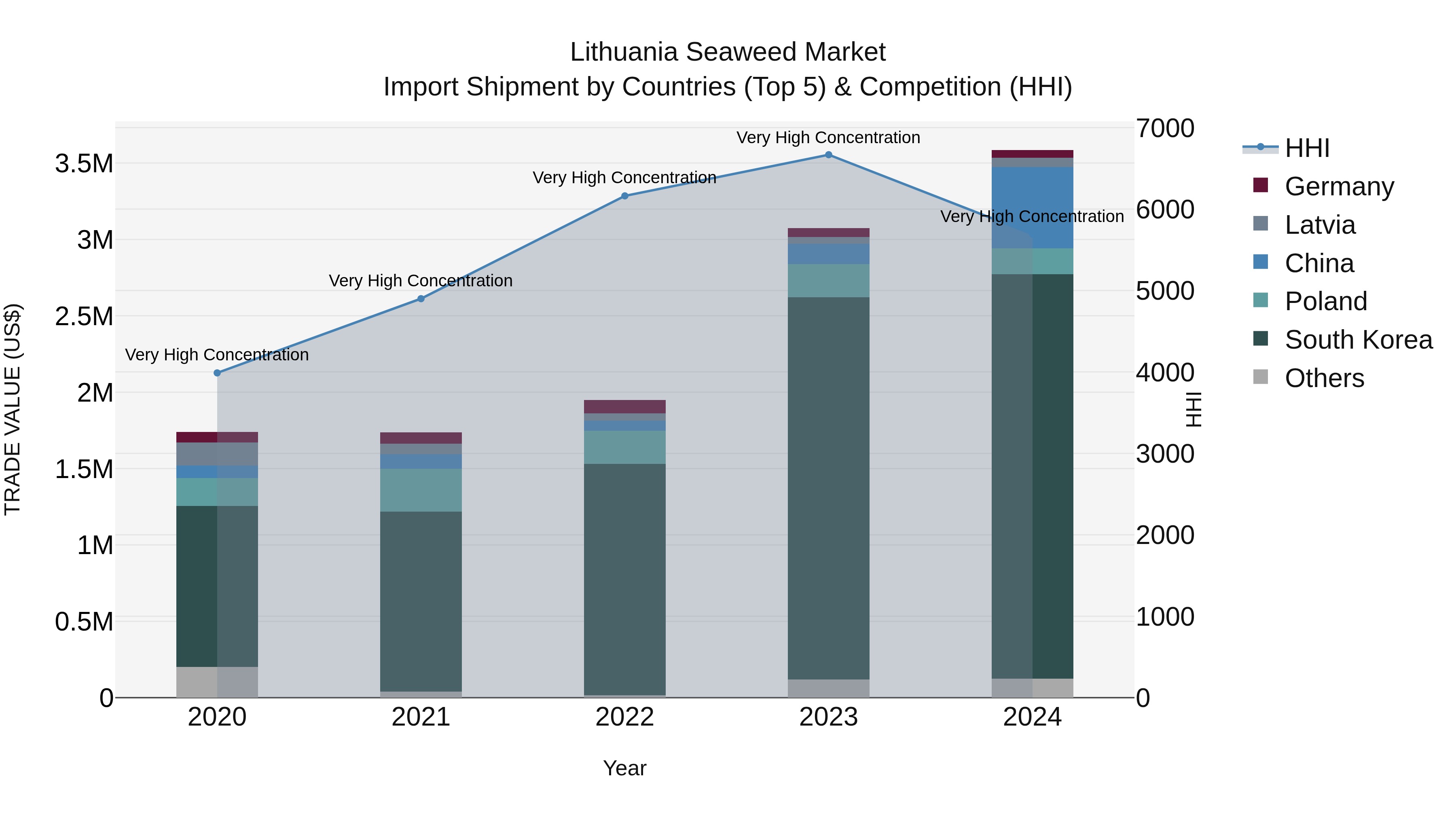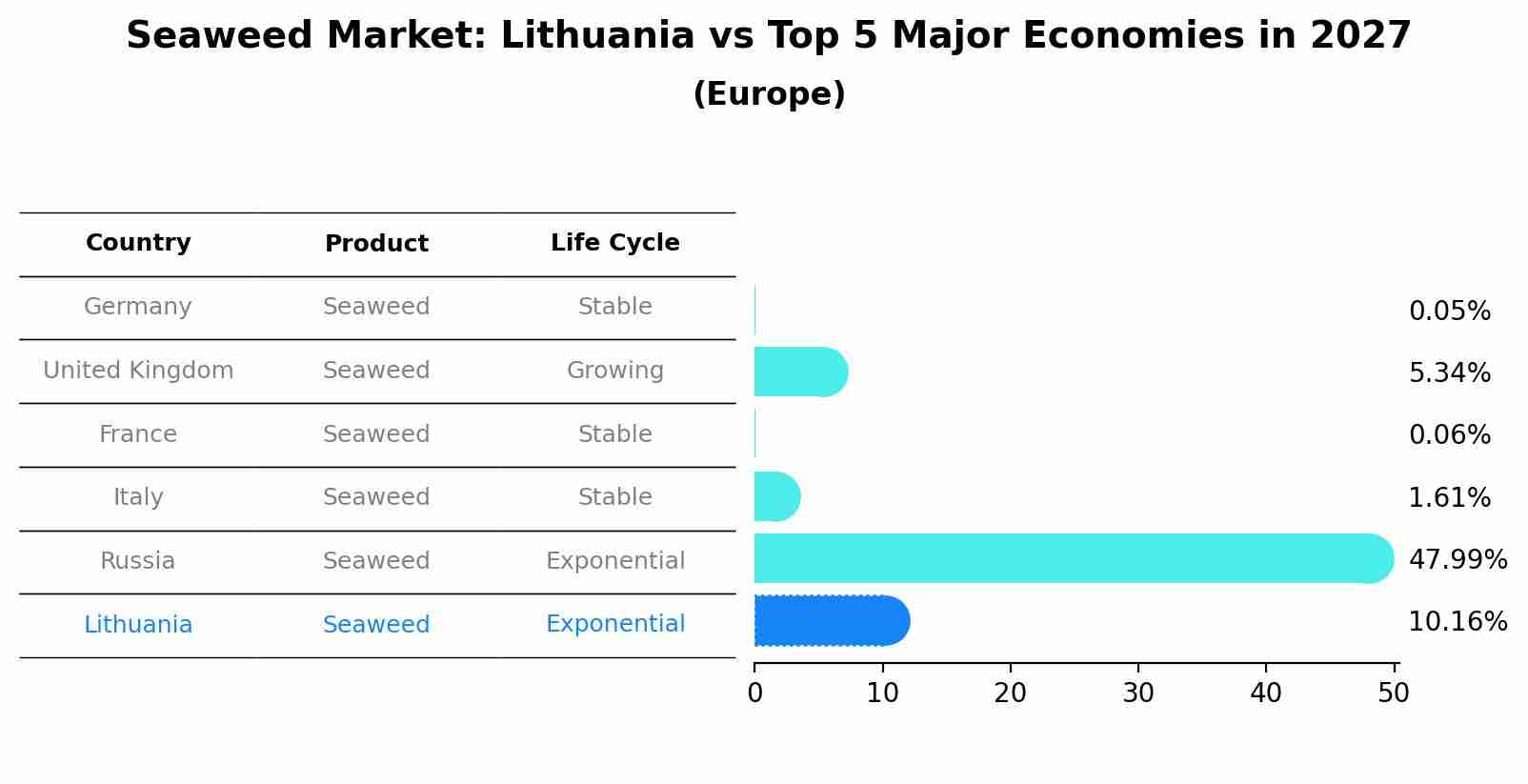Lithuania Seaweed Market (2025-2031) | Growth, Industry, Revenue, Share, Forecast, Companies, Value, Analysis, Trends, Outlook, Segmentation & Size
| Product Code: ETC5213127 | Publication Date: Nov 2023 | Updated Date: Nov 2025 | Product Type: Market Research Report | |
| Publisher: 6Wresearch | Author: Shubham Padhi | No. of Pages: 60 | No. of Figures: 30 | No. of Tables: 5 |
Lithuania Seaweed Market Top 5 Importing Countries and Market Competition (HHI) Analysis
Lithuania`s seaweed import market in 2024 continues to thrive with top exporting countries such as South Korea, China, Poland, Latvia, and Estonia dominating the landscape. The high Herfindahl-Hirschman Index (HHI) indicates a concentrated market, while the impressive Compound Annual Growth Rate (CAGR) of 19.83% from 2020 to 2024 underscores the sector`s rapid expansion. The substantial growth rate of 16.64% from 2023 to 2024 further highlights the increasing demand for seaweed imports in Lithuania, promising opportunities for both domestic and international suppliers.

Seaweed Market: Lithuania vs Top 5 Major Economies in 2027 (Europe)
By 2027, Lithuania's Seaweed market is forecasted to achieve a high growth rate of 10.16%, with Germany leading the Europe region, followed by United Kingdom, France, Italy and Russia.

Key Highlights of the Report:
- Lithuania Seaweed Market Outlook
- Market Size of Lithuania Seaweed Market, 2024
- Forecast of Lithuania Seaweed Market, 2031
- Historical Data and Forecast of Lithuania Seaweed Revenues & Volume for the Period 2021-2031
- Lithuania Seaweed Market Trend Evolution
- Lithuania Seaweed Market Drivers and Challenges
- Lithuania Seaweed Price Trends
- Lithuania Seaweed Porter`s Five Forces
- Lithuania Seaweed Industry Life Cycle
- Historical Data and Forecast of Lithuania Seaweed Market Revenues & Volume By Product for the Period 2021-2031
- Historical Data and Forecast of Lithuania Seaweed Market Revenues & Volume By Red for the Period 2021-2031
- Historical Data and Forecast of Lithuania Seaweed Market Revenues & Volume By Brown for the Period 2021-2031
- Historical Data and Forecast of Lithuania Seaweed Market Revenues & Volume By Green for the Period 2021-2031
- Historical Data and Forecast of Lithuania Seaweed Market Revenues & Volume By Application for the Period 2021-2031
- Historical Data and Forecast of Lithuania Seaweed Market Revenues & Volume By Human Food for the Period 2021-2031
- Historical Data and Forecast of Lithuania Seaweed Market Revenues & Volume By Hydrocolloids for the Period 2021-2031
- Historical Data and Forecast of Lithuania Seaweed Market Revenues & Volume By Fertilizers for the Period 2021-2031
- Historical Data and Forecast of Lithuania Seaweed Market Revenues & Volume By Animal Feed Additives for the Period 2021-2031
- Historical Data and Forecast of Lithuania Seaweed Market Revenues & Volume By Others for the Period 2021-2031
- Lithuania Seaweed Import Export Trade Statistics
- Market Opportunity Assessment By Product
- Market Opportunity Assessment By Application
- Lithuania Seaweed Top Companies Market Share
- Lithuania Seaweed Competitive Benchmarking By Technical and Operational Parameters
- Lithuania Seaweed Company Profiles
- Lithuania Seaweed Key Strategic Recommendations
Frequently Asked Questions About the Market Study (FAQs):
1 Executive Summary |
2 Introduction |
2.1 Key Highlights of the Report |
2.2 Report Description |
2.3 Market Scope & Segmentation |
2.4 Research Methodology |
2.5 Assumptions |
3 Lithuania Seaweed Market Overview |
3.1 Lithuania Country Macro Economic Indicators |
3.2 Lithuania Seaweed Market Revenues & Volume, 2021 & 2031F |
3.3 Lithuania Seaweed Market - Industry Life Cycle |
3.4 Lithuania Seaweed Market - Porter's Five Forces |
3.5 Lithuania Seaweed Market Revenues & Volume Share, By Product, 2021 & 2031F |
3.6 Lithuania Seaweed Market Revenues & Volume Share, By Application, 2021 & 2031F |
4 Lithuania Seaweed Market Dynamics |
4.1 Impact Analysis |
4.2 Market Drivers |
4.2.1 Increasing consumer awareness about the health benefits of seaweed consumption |
4.2.2 Growing popularity of plant-based diets and veganism |
4.2.3 Rising demand for natural and organic food products |
4.3 Market Restraints |
4.3.1 Limited availability of seaweed resources in Lithuania |
4.3.2 Seasonal variations in seaweed harvesting affecting supply |
4.3.3 Lack of standardized regulations and quality control measures in the industry |
5 Lithuania Seaweed Market Trends |
6 Lithuania Seaweed Market Segmentations |
6.1 Lithuania Seaweed Market, By Product |
6.1.1 Overview and Analysis |
6.1.2 Lithuania Seaweed Market Revenues & Volume, By Red, 2021-2031F |
6.1.3 Lithuania Seaweed Market Revenues & Volume, By Brown, 2021-2031F |
6.1.4 Lithuania Seaweed Market Revenues & Volume, By Green, 2021-2031F |
6.2 Lithuania Seaweed Market, By Application |
6.2.1 Overview and Analysis |
6.2.2 Lithuania Seaweed Market Revenues & Volume, By Human Food, 2021-2031F |
6.2.3 Lithuania Seaweed Market Revenues & Volume, By Hydrocolloids, 2021-2031F |
6.2.4 Lithuania Seaweed Market Revenues & Volume, By Fertilizers, 2021-2031F |
6.2.5 Lithuania Seaweed Market Revenues & Volume, By Animal Feed Additives, 2021-2031F |
6.2.6 Lithuania Seaweed Market Revenues & Volume, By Others, 2021-2031F |
7 Lithuania Seaweed Market Import-Export Trade Statistics |
7.1 Lithuania Seaweed Market Export to Major Countries |
7.2 Lithuania Seaweed Market Imports from Major Countries |
8 Lithuania Seaweed Market Key Performance Indicators |
8.1 Number of new seaweed-based products introduced in the market |
8.2 Percentage increase in seaweed cultivation areas in Lithuania |
8.3 Consumer perception and awareness surveys on seaweed consumption benefits |
9 Lithuania Seaweed Market - Opportunity Assessment |
9.1 Lithuania Seaweed Market Opportunity Assessment, By Product, 2021 & 2031F |
9.2 Lithuania Seaweed Market Opportunity Assessment, By Application, 2021 & 2031F |
10 Lithuania Seaweed Market - Competitive Landscape |
10.1 Lithuania Seaweed Market Revenue Share, By Companies, 2024 |
10.2 Lithuania Seaweed Market Competitive Benchmarking, By Operating and Technical Parameters |
11 Company Profiles |
12 Recommendations | 13 Disclaimer |
- Single User License$ 1,995
- Department License$ 2,400
- Site License$ 3,120
- Global License$ 3,795
Search
Thought Leadership and Analyst Meet
Our Clients
Related Reports
- Canada Oil and Gas Market (2026-2032) | Share, Segmentation, Value, Industry, Trends, Forecast, Analysis, Size & Revenue, Growth, Competitive Landscape, Outlook, Companies
- Germany Breakfast Food Market (2026-2032) | Industry, Share, Growth, Size, Companies, Value, Analysis, Revenue, Trends, Forecast & Outlook
- Australia Briquette Market (2025-2031) | Growth, Size, Revenue, Forecast, Analysis, Trends, Value, Share, Industry & Companies
- Vietnam System Integrator Market (2025-2031) | Size, Companies, Analysis, Industry, Value, Forecast, Growth, Trends, Revenue & Share
- ASEAN and Thailand Brain Health Supplements Market (2025-2031) | Strategy, Consumer Insights, Analysis, Investment Trends, Opportunities, Growth, Size, Share, Industry, Revenue, Segments, Value, Segmentation, Supply, Forecast, Restraints, Outlook, Competition, Drivers, Trends, Demand, Pricing Analysis, Competitive, Strategic Insights, Companies, Challenges
- ASEAN Bearings Market (2025-2031) | Strategy, Consumer Insights, Analysis, Investment Trends, Opportunities, Growth, Size, Share, Industry, Revenue, Segments, Value, Segmentation, Supply, Forecast, Restraints, Outlook, Competition, Drivers, Trends, Demand, Pricing Analysis, Competitive, Strategic Insights, Companies, Challenges
- Europe Flooring Market (2025-2031) | Outlook, Share, Industry, Trends, Forecast, Companies, Revenue, Size, Analysis, Growth & Value
- Saudi Arabia Manlift Market (2025-2031) | Outlook, Size, Growth, Trends, Companies, Industry, Revenue, Value, Share, Forecast & Analysis
- Uganda Excavator, Crane, and Wheel Loaders Market (2025-2031) | Strategy, Consumer Insights, Analysis, Investment Trends, Opportunities, Growth, Size, Share, Industry, Revenue, Segments, Value, Segmentation, Supply, Forecast, Restraints, Outlook, Competition, Drivers, Trends, Demand, Pricing Analysis, Competitive, Strategic Insights, Companies, Challenges
- Rwanda Excavator, Crane, and Wheel Loaders Market (2025-2031) | Strategy, Consumer Insights, Analysis, Investment Trends, Opportunities, Growth, Size, Share, Industry, Revenue, Segments, Value, Segmentation, Supply, Forecast, Restraints, Outlook, Competition, Drivers, Trends, Demand, Pricing Analysis, Competitive, Strategic Insights, Companies, Challenges
Industry Events and Analyst Meet
Whitepaper
- Middle East & Africa Commercial Security Market Click here to view more.
- Middle East & Africa Fire Safety Systems & Equipment Market Click here to view more.
- GCC Drone Market Click here to view more.
- Middle East Lighting Fixture Market Click here to view more.
- GCC Physical & Perimeter Security Market Click here to view more.
6WResearch In News
- Doha a strategic location for EV manufacturing hub: IPA Qatar
- Demand for luxury TVs surging in the GCC, says Samsung
- Empowering Growth: The Thriving Journey of Bangladesh’s Cable Industry
- Demand for luxury TVs surging in the GCC, says Samsung
- Video call with a traditional healer? Once unthinkable, it’s now common in South Africa
- Intelligent Buildings To Smooth GCC’s Path To Net Zero


















